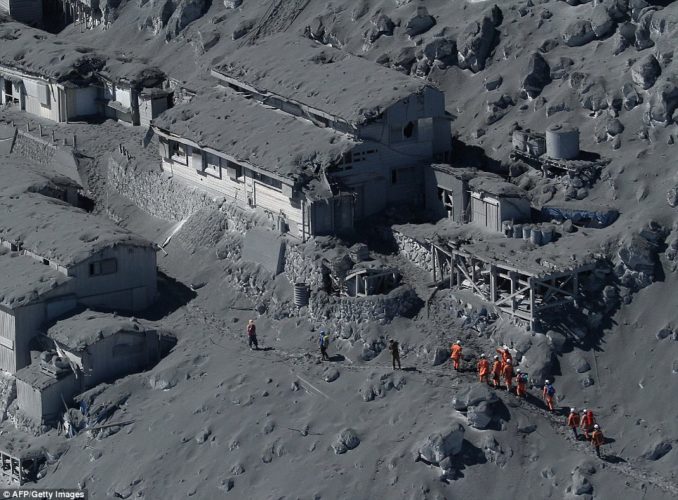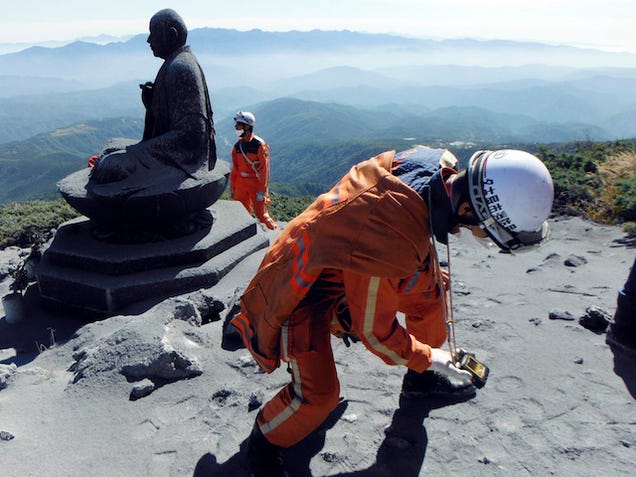
Five more bodies have been found on the slopes of Japan's Mount Ontake, bringing the total number of presumed dead in a volcanic eruption Saturday to 36.
Twenty-four bodies still remain on the mountain, while 12 have been recovered, identified and pronounced dead, Nagano Prefecture Police said Monday.
The search for more missing hikers has been suspended due to dangerous conditions at summit. Hydrogen sulfide gas is being spewed from the mountain, police said, putting rescuers in danger.
The volcano in central Japan unleashed a huge cloud of ash late Saturday morning that billowed down the mountainside and engulfed hikers in its path. Witnesses described hearing a sound like thunder when the eruption began.
Relatives of the missing gathered near Mount Ontake over the weekend desperately seeking information. Among them was Kiyokazu Tokoro from nearby Aichi prefecture, whose son, Yuki, was hiking on the volcano with his girlfriend.
He said he knew they were near the summit at the time of the eruption because his son's girlfriend had sent a photo to a friend minutes beforehand.
"All I can do is beg for your help to get information," he told CNN. "Please help us."
Authorities estimated there were 200 to 250 hikers in the area at the time of the eruption. Most of them were reported to have managed to make the long trek down the mountain.
But some people remained trapped in several lodges on Mount Ontake, and others were missing altogether, local authorities said.
More than 350 rescue workers -- a mix of police, firefighters and military personnel -- began climbing two separate routes up the mountain on Sunday morning, authorities in the nearby village of Otaki said.
They said they observed 17-20 inches (40-50 centimeters) of volcanic ash covering the ground in some areas.
The Japan Meteorological Agency has raised the Volcanic Alert Level for Ontake from 1 to 3. That means the public is advised to not approach the volcano, the summit of which is at an altitude of 10,060 feet (3,067 meters).
The agency warned that another large eruption could take place in the next six days or so. Small continuous eruptions continued Sunday.
The volcano's plume of smoke and ash was reported to have disrupted air travel in Japan, causing delays at several airports.
Mount Ontake, the second tallest volcano in Japan, after Mount Fuji, is a popular destination for hikers, especially in the fall when the foliage's rich autumn colors are on display.
The last major eruption of Mount Ontake, which is about 125 miles (200 kilometers) west of Tokyo, took place in 1979, according to the Global Volcanism Program at the Smithsonian Institute.
That eruption lasted months, spewing out more than 200,000 tons of ash, the Japanese news agency Kyodo reported.
Japan is one of the world's most seismically active nations - but there have been no fatalities from volcanic eruptions since 1991, when 43 people died at Mount Unzen in the south-west.
Saturday's eruption forced many of those on the mountain to make emergency descents through clouds of volcanic ash and falling rocks.
"The volcanic rocks fell like hailstones," one man said.
"We couldn't breathe so we covered our mouths with towels. We couldn't open our eyes either."
Another told reporters: "The volcanic ash was hurtling so fast I couldn't run away. I'm worried about people still on the mountain."
Almost 50 people were thought to have stayed on the mountain on Saturday night, reports said.
Rescue efforts will resume on Monday after an intense search on Sunday was called off because of toxic volcanic gases in the area.
Japanese officials can only announce deaths after a formal doctor's examination.
The question many people have been asking is - why were there hundreds of people on top of an active volcano? And, why was there no warning it was about to erupt?
The answer to the first question is that there are lots of active volcanos in Japan, and people hike on them all the time. I have done so myself. Mount Fuji is classed as an active volcano, and hundreds of thousands of people climb it every year.
In some ways the people caught in Saturday's eruption were very unlucky. It was a beautiful sunny Saturday at the peak of the autumn hiking season. Had it been a rainy Wednesday in June the chances are very few people would have been up there.
The question of no warning is harder to answer. Volcanologists point out this was a relatively small eruption, and that it was driven by super-heated steam and ash, not by lava being ejected from the magma chamber. That made it much more difficult to predict.
But it also meant that many of those caught up in the eruption survived. Had it been a large-scale eruption (like the one in 1979) with large pyroclastic flows, many more would have been killed.
Monday 29 September 2014
http://www.bbc.co.uk/news/world-asia-29399306
http://edition.cnn.com/2014/09/29/world/asia/japan-volcano-ontake/












